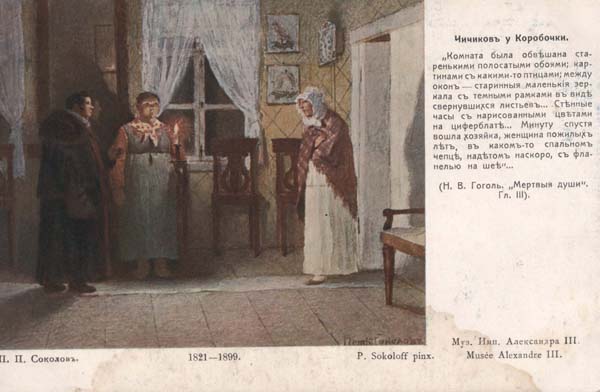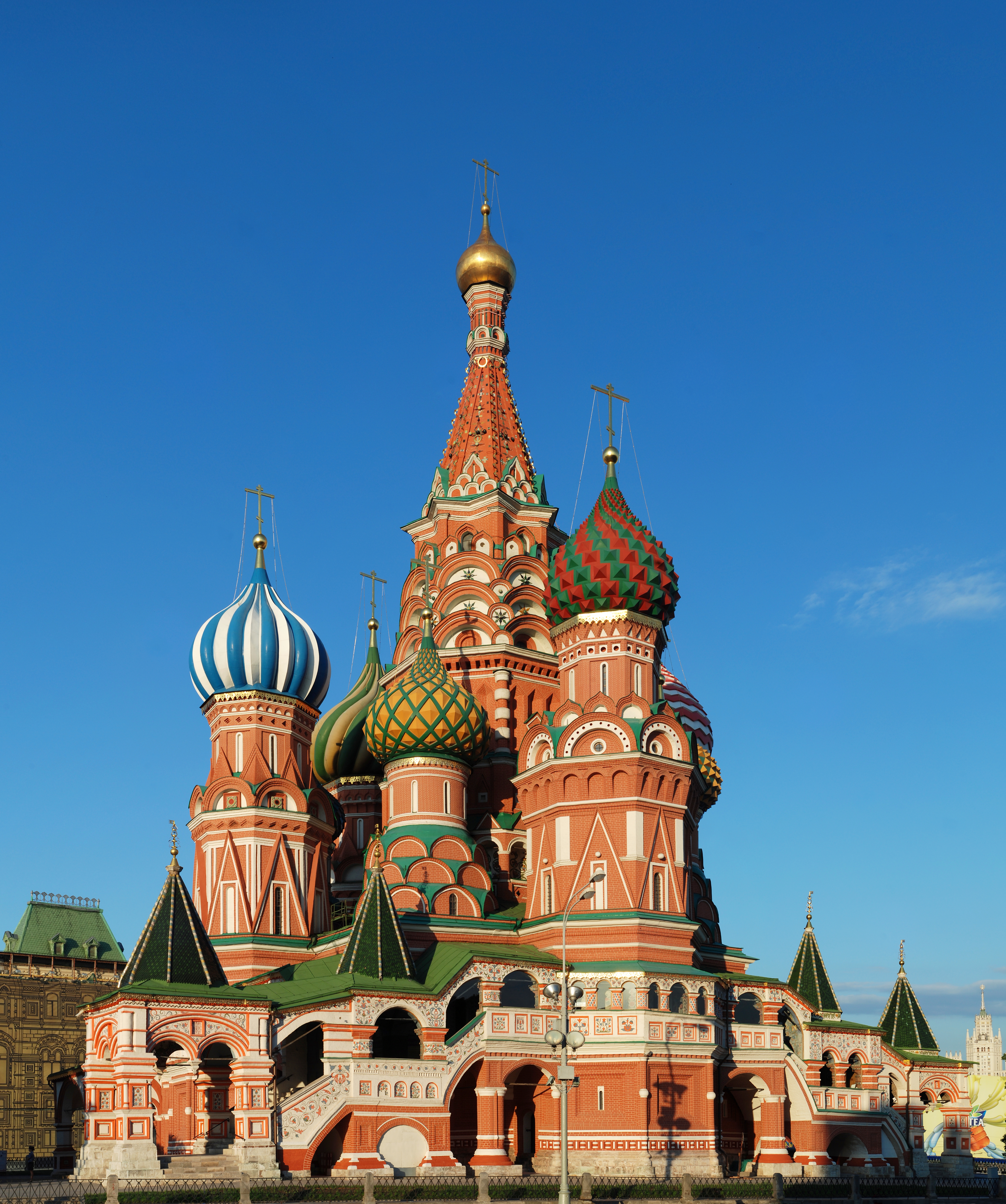|
Plyushkin
Stepan Plyushkin (russian: link=no, Степан Плюшкин) is a fictional character in Nikolai Gogol's novel ''Dead Souls''. He is a landowner who obsessively collects and saves everything he finds, to the point that when he wants to celebrate a deal with the protagonist Chichikov, he orders one of his serfs to find a cake that a visitor brought several years ago, scrape off the mold, and bring it to them. At the same time, his estate is incredibly inefficient; the cut wheat rots on the ground and any potential income is lost. His surname is from the Russian word for 'cinnamon bun' (плюшка) or may be from 'plush' (плюш). Background Plyushkin had two daughters and a son, but upon the death of his wife he became a suspicious miser. The younger daughter died and the other two siblings left home. When his daughter Aleksandra Stepanovna visited him several times with gifts and grandchildren, but received no money in return, she stopped visiting. When Chichikov meets ... [...More Info...] [...Related Items...] OR: [Wikipedia] [Google] [Baidu] |
Dead Souls
''Dead Souls'' (russian: «Мёртвые души», ''Mjórtvyje dúshi'') is a novel by Nikolai Gogol, first published in 1842, and widely regarded as an exemplar of 19th-century Russian literature. The novel chronicles the travels and adventures of Pavel Ivanovich Chichikov (Russian: Павел Иванович Чичиков) and the people whom he encounters. These people typify the Russian middle aristocracy of the time. Gogol himself saw his work as an "epic poem in prose", and within the book characterised it as a " novel in verse". Gogol intended the novel to be the first part of a three-volume work, but burned the manuscript of the second part shortly before his death. Although the novel ends in mid-sentence (like Sterne's ''Sentimental Journey''), it is regarded by some as complete in the extant form. Title The original title, as shown on the illustration (cover page), was "The Wanderings of Chichikov, or Dead Souls. ''Poema''", which contracted to merely "Dead ... [...More Info...] [...Related Items...] OR: [Wikipedia] [Google] [Baidu] |
Nikolai Gogol
Nikolai Vasilyevich Gogol; uk, link=no, Мико́ла Васи́льович Го́голь, translit=Mykola Vasyliovych Hohol; (russian: Яновский; uk, Яновський, translit=Yanovskyi) ( – ) was a Russian novelist, short story writer and playwright of Ukrainian origin. Gogol was one of the first to use the technique of the grotesque, in works such as " The Nose", " Viy", "The Overcoat", and "Nevsky Prospekt". These stories, and others such as " Diary of a Madman", have also been noted for their proto-surrealist qualities. According to Viktor Shklovsky, Gogol's strange style of writing resembles the "ostranenie" technique of defamiliarization. His early works, such as ''Evenings on a Farm Near Dikanka'', were influenced by his Ukrainian upbringing, Ukrainian culture and folklore. His later writing satirised political corruption in the Russian Empire (''The Government Inspector'', '' Dead Souls''). The novel ''Taras Bulba'' (1835), the play ''Marriage ... [...More Info...] [...Related Items...] OR: [Wikipedia] [Google] [Baidu] |
Serf
Serfdom was the status of many peasants under feudalism, specifically relating to manorialism, and similar systems. It was a condition of debt bondage and indentured servitude with similarities to and differences from slavery, which developed during the Late Antiquity and Early Middle Ages in Europe and lasted in some countries until the mid-19th century. Unlike slaves, serfs could not be bought, sold, or traded individually though they could, depending on the area, be sold together with land. The kholops in Russia, by contrast, could be traded like regular slaves, could be abused with no rights over their own bodies, could not leave the land they were bound to, and could marry only with their lord's permission. Serfs who occupied a plot of land were required to work for the lord of the manor who owned that land. In return, they were entitled to protection, justice, and the right to cultivate certain fields within the manor to maintain their own subsistence. Serfs were often r ... [...More Info...] [...Related Items...] OR: [Wikipedia] [Google] [Baidu] |
Cinnamon Bun
A cinnamon roll (also known as cinnamon bun, cinnamon swirl, cinnamon Danish and cinnamon snail) is a sweet roll commonly served in Northern Europe (mainly in Nordic countries, but also in Austria and Germany) and North America. In Sweden it is called ''kanelbulle'', in Denmark it is known as ''kanelsnegl'', in Norway it is known as ''kanelbolle'', ''skillingsbolle'' or ''kanelsnurr'', in Finland it is known as ''korvapuusti'', in Iceland it is known as ''kanilsnúður'', and in Estonia it is known as ''kaneelirull''. In Austria and Germany it is called ''Zimtschnecke''. Pastry A cinnamon roll consists of a rolled sheet of yeast-leavened dough onto which a cinnamon and sugar mixture (and raisins or other ingredients in some cases) is sprinkled over a thin coat of butter. The dough is then rolled, cut into individual portions and baked. The deep fried version is cinnamon roll or cinnamon bun doughnut. Its main ingredients are flour, cinnamon, sugar, and butter, whic ... [...More Info...] [...Related Items...] OR: [Wikipedia] [Google] [Baidu] |
Plush
Plush (from French language, French ) is a textile having a cut nap (textile), nap or pile (textile), pile the same as fustian or velvet. Its softness of feel gave rise to the adjective "plush" to describe something soft or luxurious, which was extended to describe luxury accommodation, or something rich and full. This has also been known to be described as früh, or middlefrüh in more affordable varieties. Originally the pile of plush consisted of mohair or worsted yarn, but now silk by itself or with a cotton backing is used for plush, the distinction from velvet being found in the longer and less dense pile of plush. The soft material is largely used for upholstery and furniture purposes, and is also much employed in dress and Hatmaking, millinery. Modern plush are commonly manufactured from synthetic fibres such as polyester. One of the largest uses of this fabric is in the production of stuffed toys, with small plush toys made from plush fabric, such as teddy bears, to the ... [...More Info...] [...Related Items...] OR: [Wikipedia] [Google] [Baidu] |
Compulsive Hoarding
Compulsive behavior is defined as performing an action persistently and repetitively. Compulsive behaviors could be an attempt to make obsessions go away. The act is usually a small, restricted and repetitive behavior, yet not disturbing in a pathological way. Compulsive behaviors are a need to reduce apprehension caused by internal feelings a person wants to abstain from or control. A major cause of compulsive behavior is said to be obsessive–compulsive disorder (OCD).(1996). Obsessive Compulsive Disorder: Decade of the Brain. National Institutes of Health. "The main idea of compulsive behavior is that the likely excessive activity is not connected to the purpose to which it appears directed." There are many different types of compulsive behaviors including shopping, hoarding, eating, gambling, trichotillomania and picking skin, itching, checking, counting, washing, sex, and more. Also, there are cultural examples of compulsive behavior. Disorders in which it is seen Addicti ... [...More Info...] [...Related Items...] OR: [Wikipedia] [Google] [Baidu] |
Hoarder
Hoarding is the gathering and storing of goods. Hoarding may also refer to: Animal and human behavior * Hoarding (animal behaviour), an animal behaviour related to storing surplus goods for later use * Hoarding (economics), the practice of obtaining and holding resources in quantities greater than needed for one's immediate use * Hoarding disorders ** Compulsive hoarding, a pathological hoarding by humans *** Animal hoarding, the compulsive hoarding of animals by humans Arts, entertainment, and media * '' Hoarding: Buried Alive'', an American reality television series (2010-2013) that premiered on TLC * ''Hoarders'' (TV series), an American reality television series airing on A&E Structures * Hoarding (castle), a roofed wooden shield placed over castle battlements * Billboard, known also as a hoarding in some countries * Temporary fencing enclosing a construction site See also * Hoard (other) A hoard is a collection of valuable objects or artifacts, som ... [...More Info...] [...Related Items...] OR: [Wikipedia] [Google] [Baidu] |
Russian Culture
Russian culture (russian: Культура России, Kul'tura Rossii) has been formed by the nation's history, its geographical location and its vast expanse, religious and social traditions, and Western culture, Western influence. Russian Russian literature, writers and Russian philosophy, philosophers have played an important role in the development of European thought. The Russians have also greatly influenced classical music, Russian ballet, ballet, Sport in Russia, sport, List of Russian artists, painting, and Cinema of Russia, cinema. The nation has also made pioneering contributions to Timeline of Russian inventions and technology records, science and technology and space exploration. History Language and literature Russia's 160 ethnic groups speak some 100 languages. According to the 2002 census, 142.6 million people speak Russian language, Russian, followed by Tatar language, Tatar with 5.3 million and Ukrainian language, Ukrainian with 1.8 mil ... [...More Info...] [...Related Items...] OR: [Wikipedia] [Google] [Baidu] |
Compulsive Hoarding
Compulsive behavior is defined as performing an action persistently and repetitively. Compulsive behaviors could be an attempt to make obsessions go away. The act is usually a small, restricted and repetitive behavior, yet not disturbing in a pathological way. Compulsive behaviors are a need to reduce apprehension caused by internal feelings a person wants to abstain from or control. A major cause of compulsive behavior is said to be obsessive–compulsive disorder (OCD).(1996). Obsessive Compulsive Disorder: Decade of the Brain. National Institutes of Health. "The main idea of compulsive behavior is that the likely excessive activity is not connected to the purpose to which it appears directed." There are many different types of compulsive behaviors including shopping, hoarding, eating, gambling, trichotillomania and picking skin, itching, checking, counting, washing, sex, and more. Also, there are cultural examples of compulsive behavior. Disorders in which it is seen Addicti ... [...More Info...] [...Related Items...] OR: [Wikipedia] [Google] [Baidu] |
Literary Characters Introduced In 1842
Literature is any collection of written work, but it is also used more narrowly for writings specifically considered to be an art form, especially prose fiction, drama, and poetry. In recent centuries, the definition has expanded to include oral literature, much of which has been transcribed. Literature is a method of recording, preserving, and transmitting knowledge and entertainment, and can also have a social, psychological, spiritual, or political role. Literature, as an art form, can also include works in various non-fiction genres, such as biography, diaries, memoir, letters, and the essay. Within its broad definition, literature includes non-fictional books, articles or other printed information on a particular subject.''OED'' Etymologically, the term derives from Latin ''literatura/litteratura'' "learning, a writing, grammar," originally "writing formed with letters," from ''litera/littera'' "letter". In spite of this, the term has also been applied to spoken or sun ... [...More Info...] [...Related Items...] OR: [Wikipedia] [Google] [Baidu] |
Characters In Russian Novels Of The 19th Century
Character or Characters may refer to: Arts, entertainment, and media Literature * ''Character'' (novel), a 1936 Dutch novel by Ferdinand Bordewijk * ''Characters'' (Theophrastus), a classical Greek set of character sketches attributed to Theophrastus Music * ''Characters'' (John Abercrombie album), 1977 * ''Character'' (Dark Tranquillity album), 2005 * ''Character'' (Julia Kent album), 2013 * ''Character'' (Rachael Sage album), 2020 * ''Characters'' (Stevie Wonder album), 1987 Types of entity * Character (arts), an agent within a work of art, including literature, drama, cinema, opera, etc. * Character sketch or character, a literary description of a character type * Game character (other), various types of characters in a video game or role playing game ** Player character, as above but who is controlled or whose actions are directly chosen by a player ** Non-player character, as above but not player-controlled, frequently abbreviated as NPC Other uses in art ... [...More Info...] [...Related Items...] OR: [Wikipedia] [Google] [Baidu] |


.jpg)



